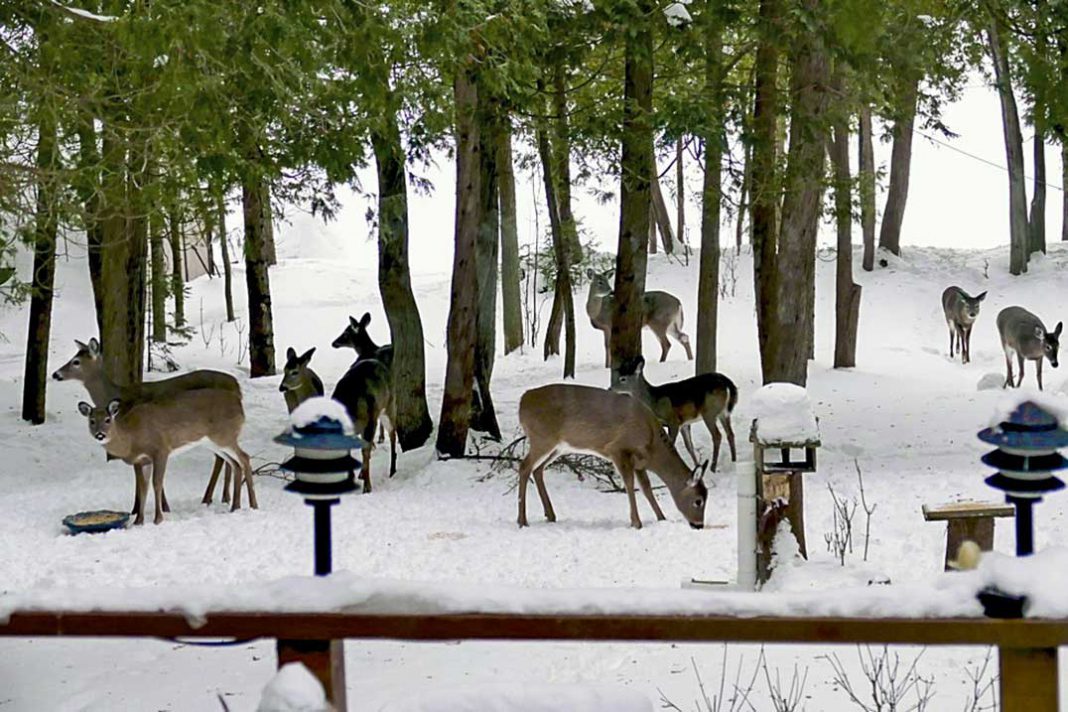MANITOULIN—Deer Save activities have been underway on Manitoulin Island throughout February and, as temperatures are now well back below freezing, they show no sign of stopping any time soon.
Manitoulin Streams Improvement Association, which has been organizing Deer Save activities on Manitoulin Island, says it expects to have bulldozers working to break deer trails at some point this week.
“We will be doing bulldozing around Gore Bay and the Barrie Island area, and some of the south shore area. Bulldozing will be opening up key area trails that are somewhat close to deer yards,” says Sue Meert, Deer Save co-ordinator at Manitoulin Streams.
“The deer are a natural resource that brings money to the Island. And it’s a way of life, there are people here who depend on hunting and providing that meat to their families. It’s very important,” she says.
Deer Save has existed since 1995 as an initiative of the Ontario Federation of Anglers and Hunters (OFAH). OFAH maintains its DeerSave Fund, money it has set aside for localized groups that need assistance conducting Deer Save activities.
“It’s a pool of money that can be made available in times of what we would consider a grave threat to the deer population from winter conditions,” says Keith Munro, administrator of the DeerSave Fund at OFAH.
The deer are currently having a particularly tough time near Gore Bay, but Ms. Meert says deer in other areas are also in a lot of trouble, adding that “we need to get moving quick.”
“These issues tend to be very localized,” says Mr. Munro, adding that Manitoulin Island and the North Shore area are currently the only two areas that have requested emergency assistance for their Deer Save activities.
“We have people on the ground in local areas, combined with winter severity data collected by MNRF (Ontario Ministry of Natural Resources and Forestry), they’ve got a really good picture of what the situation is like locally. Efforts are initiated locally, and we come in and support them,” says Mr. Munro.
In the Gore Bay area, H&R Noble has stepped in to offer bulldozing services.
“They’ve given us some amazing pricing. They have been great at doing their own properties already,” says Ms. Meert. “This is amazing from them. We’re very appreciative.”
Ms. Meert says she is still gathering quotes for the south shore bulldozing and may end up working with multiple providers. She says the work is ongoing with landowners as well to blaze deer trails on their properties.
“We’re not looking to scrape snow right down to the ground, there can be some leeway there, but just enough to get the path opened up so they can get to the cedar that’s already existing in many areas,” Ms. Meert says.
All applicants for Deer Save funding must be an organized hunt camp, conservation organization, club or community group. Those who have previously worked with MNRF on conservation activities are given a higher priority. The group representing the North Shore is the Espanola Game and Fish Protective Association.
“Our first priority is ensuring that these natural resources will be available for future generations. This really is a step in that. OFAH doesn’t support the ongoing feeding of deer throughout the winter, but we do support emergency feeding and these emergency measures when there is a risk to the population,” Mr. Munro says.
Ms. Meert says her group generally does not support deer feeding, because if they are fed incorrectly, such as with grains, it can devastate their digestive tracts. Their main focus is cutting higher cedar that the deer would otherwise not be able to reach.
“Additionally, people can also cut cedar, hemlock and hardwood browse along these trails as natural sources of food for deer,” says Maimoona Dinani, spokesperson for the MNRF.
“Persistent cold temperatures and ice crust part way down in the snow pack contributed in making this a very hard winter for deer and other wildlife. The significance of these impacts will largely depend on how things play out over the next months,” Ms. Dinani writes in an email to The Expositor.
At this point, identifying when the winter might end is a challenging task.
“Winter can go right up to the end of March. Depending on snow levels and the crust levels, we’ll try to keep going,” Ms. Meert says. “As long as the funding keeps coming in, we have good weather conditions and the availability of volunteers, we’ll keep going to the point where the snow is not hindering them.”
She adds that deer are significant to Manitoulin not only for the economic impacts of the annual hunting season, but also because of the ecosystem as a whole.
“We at Manitoulin Streams are all about conservation,” she says. “It’s a natural, beautiful area, and the deer are a huge part of that.”
Mr. Munro says even if people are not living in areas that require Deer Save efforts, or do not have the ability to volunteer their time or property, they are welcome to donate to the DeerSave Fund which helps protect deer populations against future weather conditions and uncertainty.
“While deer are naturally adapted to survive winter and do not require assistance, a winter like this can result in a large-scale mortality of northern whitetails. The ministry applauds the efforts of local volunteers helping deer this year,” states Ms. Dinani.
Ms. Meert says anyone looking for more information can contact Manitoulin Streams through its website through the Deer Save Manitoulin Facebook page or by calling the Manitoulin Streams office at 705-859-1653. The effort is always looking for people to volunteer either their time or their property, as well as donations to help fund its ongoing operations.
“We’ve had a great response so far. We want to make sure we thank our volunteers and everybody involved in these efforts,” Ms. Meert says.





